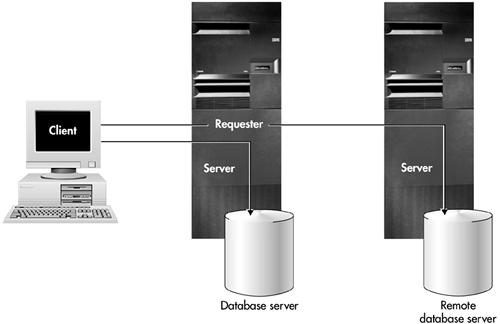Distributed data
Many businesses need to manage data from a wide variety of sources and locations. A distributed environment provides the flexibility that is required to allocate resources for data that is located at different sites or database management systems (DBMSs) in a computer network.
Distributed data is data that resides on a DBMS other than your local system. Your local DBMS is the one on which you bind your application plan. All other DBMSs are remote.
Remote servers
When you request services from a remote DBMS, the remote DBMS is a server and your local system is a requester or client. Conceptually, a server is like a food server who takes food orders, delivers food, and provides other services to customers. The customer is like the requester, or client. The server's purpose is to provide services to its clients.
A remote server can be truly remote in the physical sense (thousands of miles away), or a remote server can be part of the same operating system under which your local DBMS runs. This book generally assumes that your local DBMS is an instance of DB2 UDB for z/OS. A remote server can be another instance of DB2 UDB for z/OS also or an instance of one of many other products.
Figure 2.8 shows the client/server environment.
Connectivity
Connectivity in the client/server environment requires an architecture that can handle the stringent performance requirements of a transaction-based system and the flexibility of a decision-support system using ODBC or JDBC. The primary method that DB2 uses to provide connectivity to any number of DBMSs is Distributed Relational Database Architecture (DRDA), which is based on The Open Group technical standard. As “Distributing data and providing Web access” on page 9 explains, DRDA is an open, published architecture that enables communication between applications and database systems on disparate operating systems.
Using standard communication protocols, DB2 can bind and rebind packages at other servers and run the statements in those packages. Communication protocols are rules for managing the flow of data across a computer network, just as traffic lights and traffic rules manage the flow of car traffic. These protocols are invisible to DB2 applications. A system that uses DRDA, for example, can invoke DB2 stored procedures or request that SQL statements run at any server that complies with the DRDA standard.
In a distributed environment, applications can connect to multiple databases on different servers and can complete transactions, including commit and rollback operations, at the same time. This type of connectivity is known as a distributed unit of work.

